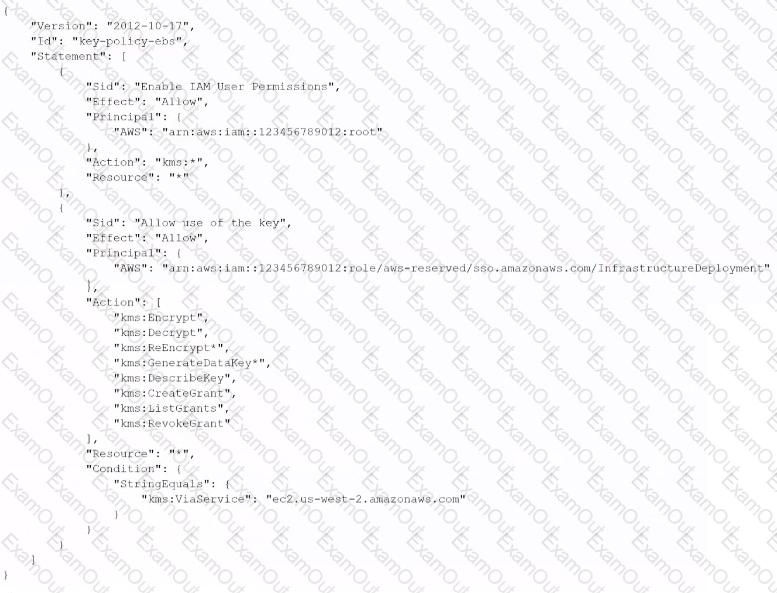A company wants to establish separate IAM Key Management Service (IAM KMS) keys to use for different IAM services. The company'ssecurityengineer created the following key policy lo allow the infrastructure deployment team to create encrypted Amazon Elastic Block Store (Amazon EBS) volumes by assuming the InfrastructureDeployment IAM role:

The security engineer recently discovered that IAM roles other than the InfrastructureDeployment role used this key (or other services. Which change to the policy should the security engineer make to resolve these issues?
A security engineer is implementing a solution to allow users to seamlessly encrypt Amazon S3 objects without having to touch the keys directly. The solution must be highlyscalable without requiring continual management. Additionally, the organization must be able to immediately delete the encryption keys.
Which solution meets these requirements?
A company usesAWS Organizations to run workloads in multiple AWS accounts Currently the individual team members at the company access all Amazon EC2 instances remotely by using SSH or Remote Desktop Protocol (RDP) The company does not have any audit trails and security groups are occasionally open The company must secure access management and implement a centralized togging solution
Which solution will meet these requirements MOST securely?
A company has a requirement that no Amazon EC2 security group can allow SSH access from the CIDR block 0.0.0.070. The company wants to monitor compliance with this requirement at all times and wants to receive a near-real-time notification if any security group is noncompliant.
A security engineer has configured AWS Config and will use the restricted-ssh managed rule to monitor the security groups.
What should the security engineer do next to meet these requirements?
Example.com is hosted on Amazon EC2 instances behind an Application Load Balancer (ALB). Third-party host intrusion detection system (HIDS) agents that capture the traffic of the EC2 instance are running on each host. The company must ensure they are using privacy enhancing technologies for users, without losing the assurance the third-party solution offers.
What is the MOST secure way to meet these requirements?
A company is storing data in Amazon S3 Glacier. A security engineer implemented a new vault lock policy for 10 TB of data and called the initiate-vault-lock operation 12hours ago. The audit team identified a typo in the policy that is allowing unintended access to the vault.
What is the MOST cost-effective way to correct this error?
An Amazon EC2 Auto Scaling group launches Amazon Linux EC2 instances and installs the Amazon CloudWatch agent to publish logs to Amazon CloudWatch Logs. The EC2 instances launch with an IAM role that has an IAM policy attached. The policy provides access to publish custom metrics to CloudWatch. The EC2 instances run in a private subnet inside a VPC. The VPC provides ^ccess to the internet for private subnets through a NAT gateway.
A security engineer notices that no logs are being published to CloudWatch Logs for the EC2 instances that the Auto Scaling group launches. The security engineer validates that the CloudWatch Logs agent is running and is configured properly on the EC2 instances. In addition, the security engineer validates that network communications are working properly to AWS services.
What can the security engineer do to ensure that the logs are published to CloudWatch Logs?
A company has a new partnership with a vendor. The vendor will process data from the company's customers. The company will upload data files as objects into an Amazon S3 bucket. The vendor will download the objects to perform data processing. The objects will contain sensi-tive data.
A security engineer must implement a solution that prevents objects from resid-ing in the S3 bucket for longer than 72 hours.
Which solution will meet these requirements?
A security engineer is checking an AWS CloudFormation template for vulnerabilities. The security engineer finds a parameter that has a default value that exposes an application's API key in plaintext. The parameter is referenced several times throughout the template. The security engineer must replace the
parameter while maintaining the ability to reference the value in the template.
Which solution will meet these requirements in the MOST secure way?
{resolve:s3:MyBucketName:MyObjectName}}.
A company has a relational database workload that runs on Amazon Aurora MySQL. According to new compliance standards the company must rotate all database credentials every 30 days. The company needs a solution that maximizes security and minimizes development effort.
Which solution will meet these requirements?

